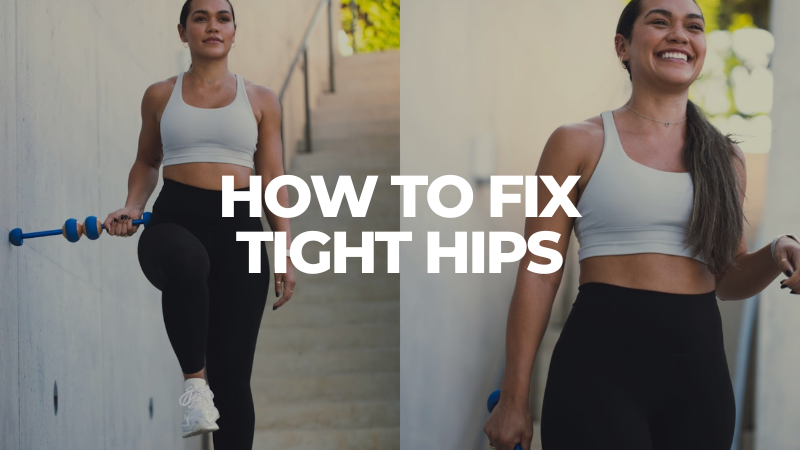A fresh new year often starts with a fitness goal in mind. This is the time of year we hit the gym or trail with a renewed sense of purpose for our goals. We’re meal prepping, organizing our days around our workouts, and eager to see progress. We’re pushing ourselves harder than ever before, which is why this is also an extremely popular time of the year for new injuries.
An injury doesn’t just mean pain and discomfort. It can mean demotivational setbacks, progress blocks, or a quick slide back into old habits. Setting out on a new fitness journey is the best time to incorporate mobility training into your routine to avoid progress destroying injuries.
These are the most common injuries we see that can sideline your goals. With more knowledge around how they form and how to prevent them, you’ll be able to stay on the path toward your goals.
1. Muscle Strains
Caused by a limited range of motion and flexibility, this injury is common in the new year as we push our muscles to do things they haven’t done before. If you jump into a workout that is more intense than you are used to before properly warming up your muscles, it’s very likely you’re going to experience muscle strains which can keep you from your workout for weeks at a time. To prevent muscle strains, it’s important to incorporate mobility work before and after your workout.

2. Delayed Onset Muscle Soreness (DOMS)
It’s very tempting to dive into a new fitness routine right off the bat, but doing too much too soon can put you at risk for DOMS. This type of muscle soreness is caused by exercise volume that increases too rapidly and lacks the proper progression and time that your muscles need to adapt. This can mean much higher levels and longevity of pain and soreness than is typical. This can cause limitations in flexibility and joint range that will set back the fitness work you’re doing and can lead to other more serious injuries. To avoid delayed onset muscle soreness, it’s important to work with a professional or program that properly increases the intensity and duration of exercise. This more gradual approach will actually result in faster and more long term results than a program that focuses on heavy overload.

3. Tendon and Bursa Injuries (Tendonitis/Bursitis)
Tendonitis is the general term for an inflamed tendon. This is seen most commonly in athletes that overuse a specific area such as shoulders for sports like tennis or lifting, hip and lower body for runners, and knee for high impact sports. These types of injuries are caused by skipping the warmup which leads to poor movement quality and technique causing tendons to overcompensate and become strained. You can easily prevent tendon injuries by making sure your soft tissues are primed for movement before engaging in your workout or sport. Having a designated warm up and cool down session along with a focus and emphasis on technique during activity will keep you from straining your tendons to make up for limited movement in your soft tissue.

4. Bone Stress Fractures
Bone fractures are common with the beginning of a new workout routine and are detrimental to progress. Bone related injuries can keep you out of the game for weeks and months at a time, resulting in major setbacks and a lot of pain. Stress fractures are among the most common and are typically the result of poor mobility work or improper footwear. This progress halting injury can be prevented by diligent soft tissue mobility work and body awareness. Athletes are used to pushing through a little bit of pain, but it’s important to remember that pain is your body’s way of telling you that something is wrong. Ignoring severe pain for longer periods of time leads to bone fractures and other serious injuries, so it’s best to listen to your body. It may be telling you to stop and take a longer warm up, ramp up more slowly, or invest in better footwear.

5. Spine and Disc Injuries
A spine or disc injury can stop a new fitness goal in its tracks, and worse, is among the most pervasive injuries, affecting your quality of life in every area. Commonly felt in the lower back, sciatica, and neck, these injuries are typically caused by repeated movements that aren’t supported by your core and put unnecessary strain on the spine. This devastating injury can be prevented with full body mobility work and core strengthening exercises that progress safely. You can also focus on releases connected to the spine to specifically to prep your body for movement and engage the muscles that protect your spine.
Across the board, a consistent mobility routine can prevent many of the major athletic injuries we see at the beginning of the year. While it’s good to look ahead and set lofty goals for ourselves, having knowledge of the impact that mobility work has on those goals is essential to achieving them.
Regardless of your goal, MOBO has the tools and education you need to prevent injury and stay in the game. Download the MOBO app (on App Store or Google Play) for release instruction by pain point, sport, activity, or muscle group. You can mix and match the recommended releases or discover the perfect mobility playlist for your goals.
Want more? Our soft tissue mobility course is the perfect pairing for New Year’s goals. Learn about mobility and fascia from founder and physical therapist Christie Powell along with instruction from VP of Education and expert in human movement, Diane Vives. With the tools and knowledge you need to prevent injury and improve movement, you’re on the road to achieve your 2022 goals!



